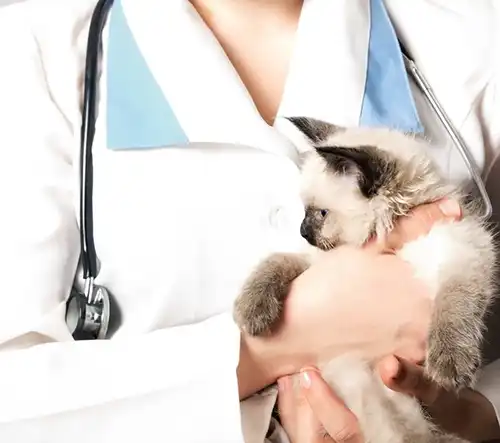Does your feline friend enjoy car rides? Chances are, she probably doesn’t. Most of our furry patients are definitely not big fans of travel. However, proper veterinary care is crucial for your cat’s health. Regardless of your pet’s opinion on the matter, she’ll look and feel better with regular appointments. An Orlando, FL vet discusses bringing your kitty into the clinic in this article.
Carrier
You should always drive with your feline pal in a crate or carrier. We would generally recommend using hard-shell carriers: these protect pets from being jostled, and are safer in case of an accident. You can use a fabric one, if you prefer. The cardboard ‘donut’ boxes will work in a pinch, but these are usually meant to be single-use options for people bringing newly-adopted pets home.
Many cats bolt for their favorite hiding spots as soon as they spot their carriers. You can help your feline pal form a more positive impression of hers. Add some comfy bedding, and give her toys, treats, and catnip near it. You may also want to leave it out between appointments. (If all else fails, tell Fluffy to stay out of it. She’ll probably jump right in!)
Drive
On the way over to the clinic, try to avoid speed bumps, potholes, sharp turns, and sudden stops and starts. Playing some soothing music may help keep your cat calm. If your feline friend is extremely nervous, ask your vet for tips on using kitty-calming products, such as pheromones.
Appointment Schedule
Fluffy’s veterinary care needs will vary, depending on her age, lifestyle, and health. If you have a kitten, you’ll need to bring your little buddy in a few times during that adorable and important first year. In addition to her initial exams, she’ll need parasite control, vaccinations, microchipping, and, of course, spay/neuter surgery. We usually recommend annual visits for healthy adult cats. Seniors may need to come in more often. Kitties with health issues also need more frequent visits, as will those who are allowed outdoors.
Emergency Visits
Cats can be secretive about letting on when they don’t feel well, but they do give off clues. Watch for warning signs. These may include things like hiding, withdrawal, vomiting, diarrhea, weight loss, respiratory issues, behavioral changes, discharge, and lack of appetite. Call your vet immediately if you notice anything unusual.
Our Advice on Taking Your Cat To The Vet in 2024
Why is a carrier important for transporting your cat?
A carrier is crucial for transporting your cat as it ensures their safety and security during travel. Hard-shell carriers offer protection from jostles and are safer in case of an accident while also preventing escape. Carriers minimize stress for your cat by providing a familiar, enclosed space and help prevent distractions for the driver, contributing to safer travel for everyone. They are essential for vet visits, emergencies, and any time your cat needs to be transported outside the home.
How can you make the car ride less stressful for your cat?
To make the car ride less stressful for your cat, start by familiarizing them with their carrier at home, using comfy bedding and treats. Keep the carrier open in a familiar space to reduce anxiety associated with it. During the drive, avoid rapid accelerations, sharp turns, and sudden stops. Playing soothing music can help calm your cat. Consider using pheromone sprays or diffusers in the car to further ease anxiety. Consult your vet for additional tips or products designed to calm stressed cats for a smoother travel experience.
What should you do if your cat gets carsick?
If your cat gets carsick, consult your veterinarian for advice and possible medication to prevent motion sickness. Prior to travel, limit your cat’s food intake to reduce the likelihood of vomiting, but always provide access to water. Ensure the carrier is stable and positioned where airflow is adequate, such as on the floor of the back seat. Covering the carrier with a light blanket can also reduce visual stimuli that contribute to motion sickness. Additionally, acclimating your cat to short, frequent car rides may help decrease their anxiety and sensitivity to motion.
What can you do to calm your cat in the waiting room?
To calm your cat in the waiting room, keep their carrier covered with a lightweight blanket to create a sense of security and minimize exposure to unfamiliar sights and sounds. Use pheromone sprays or wipes on the carrier bedding before the visit, as these can have a soothing effect. Speak to your cat in a soft, reassuring tone. Avoid opening the carrier to prevent escape or increased stress. Choosing quieter times for appointments can also help reduce anxiety by limiting exposure to other animals and noise.
Are there any specific tips for handling a cat that gets very agitated or aggressive at the vet?
For a cat that becomes very agitated or aggressive at the vet, inform the clinic staff ahead of your visit so they can prepare and potentially allocate a quiet room or a less busy time. Use a secure, comfortable carrier and familiarize your cat with it well before the appointment. Applying pheromone sprays in the carrier can help soothe your cat. Cover the carrier with a light blanket to reduce stimuli. Consider asking your vet about pre-visit sedatives or anti-anxiety medication if your cat’s stress levels are exceptionally high.
Please contact us with questions or concerns about your pet’s health or care. As your Orlando, FL animal clinic, we’re here to help!






!Social Media Icons